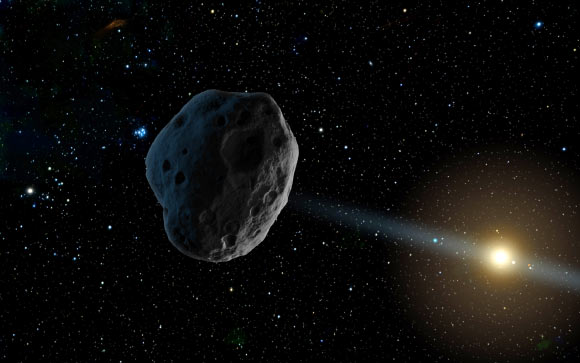Astronomers using NASA’s Wide-Field Infrared Survey Explorer (WISE) have discovered two celestial objects traveling through our neighborhood: 2016 WF9 and C/2016 U1 NEOWISE.

An artist’s rendition of 2016 WF9 as it passes Jupiter’s orbit inbound toward the Sun. Image credit: NASA / JPL-Caltech.
A near-Earth object (NEO) called 2016 WF9 was detected by the NEOWISE project — the asteroid-and-comet-hunting portion of NASA’s WISE mission — on Nov. 27, 2016.
2016 WF9 is relatively large, roughly 0.3 to 0.6 mile (0.5-1 km) across, and is rather dark, reflecting only a few percent of the light that falls on its surface.
The object resembles a comet in its reflectivity and orbit, but appears to lack the characteristic dust and gas cloud that defines a comet.
It is in an orbit that takes it on a scenic tour of the Solar System. At its farthest distance from the Sun, it approaches Jupiter’s orbit.
Over the course of 4.9 Earth-years, 2016 WF9 travels inward, passing under the main asteroid belt and the orbit of Mars until it swings just inside Earth’s own orbit. After that, it heads back toward the outer Solar System.
Objects in these types of orbits have multiple possible origins; it might once have been a comet, or it could have strayed from a population of dark objects in the main asteroid belt.
2016 WF9 will approach Earth’s orbit on Feb. 25, 2017. At a distance of nearly 32 million miles (51 million km) from our planet, this pass will not bring it particularly close.
Its trajectory is well understood, and the object is not a threat to Earth for the foreseeable future.
“2016 WF9 could have cometary origins,” said Deputy Principal Investigator Dr. James ‘Gerbs’ Bauer, from NASA’s Jet Propulsion Laboratory.
“This object illustrates that the boundary between asteroids and comets is a blurry one; perhaps over time this object has lost the majority of the volatiles that linger on or just under its surface.”
The discovery of 2016 WF9 was announced in the Minor Planet Electronic Circular (MPEC) newsletter on Nov. 30, 2016.
A different NEO, named C/2016 U1 NEOWISE, is more clearly a comet, releasing dust as it nears the Sun.
“C/2016 U1 NEOWISE has a good chance of becoming visible through a good pair of binoculars, although we can’t be sure because a comet’s brightness is notoriously unpredictable,” said Dr. Paul Chodas, manager of NASA’s Center for Near-Earth Object Studies at the Jet Propulsion Laboratory.
As seen from the northern hemisphere during the first week of 2017, C/2016 U1 NEOWISE will be in the southeastern sky shortly before dawn.
It is moving farther south each day and it will reach its closest point to the Sun, inside the orbit of Mercury, on Jan. 14, before heading back out to the outer reaches of the Solar System for an orbit lasting thousands of years.
While it will be visible to skywatchers at Earth, it is not considered a threat to our planet either.
The discovery of C/2016 U1 NEOWISE was announced in the MPEC newsletter on Nov. 3, 2016.
_____
A.F. Tubbiolo et al. 2016 WF9. Minor Planet Electronic Circular 2016, no. W125; ISSN 1523-6714
C. Wipper et al. C/2016 U1 NEOWISE. Minor Planet Electronic Circular 2016, no. V16; ISSN 1523-6714
This article is based on a press-release from NASA.







